氨基的保护
- 格式:pdf
- 大小:90.71 KB
- 文档页数:9
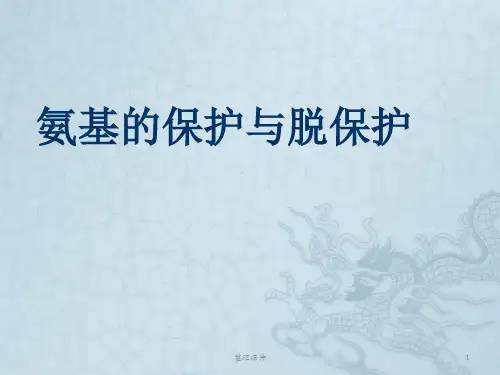
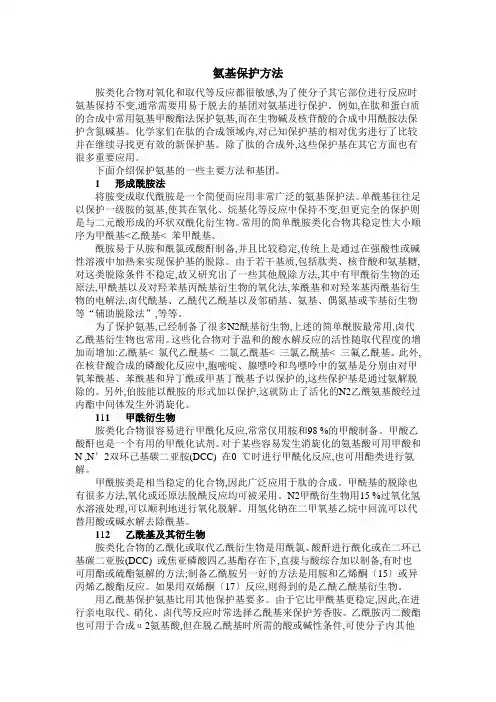
氨基保护方法胺类化合物对氧化和取代等反应都很敏感,为了使分子其它部位进行反应时氨基保持不变,通常需要用易于脱去的基团对氨基进行保护。
例如,在肽和蛋白质的合成中常用氨基甲酸酯法保护氨基,而在生物碱及核苷酸的合成中用酰胺法保护含氮碱基。
化学家们在肽的合成领域内,对已知保护基的相对优劣进行了比较并在继续寻找更有效的新保护基。
除了肽的合成外,这些保护基在其它方面也有很多重要应用。
下面介绍保护氨基的一些主要方法和基团。
1 形成酰胺法将胺变成取代酰胺是一个简便而应用非常广泛的氨基保护法。
单酰基往往足以保护一级胺的氨基,使其在氧化、烷基化等反应中保持不变,但更完全的保护则是与二元酸形成的环状双酰化衍生物。
常用的简单酰胺类化合物其稳定性大小顺序为甲酰基<乙酰基< 苯甲酰基。
酰胺易于从胺和酰氯或酸酐制备,并且比较稳定,传统上是通过在强酸性或碱性溶液中加热来实现保护基的脱除。
由于若干基质,包括肽类、核苷酸和氨基糖,对这类脱除条件不稳定,故又研究出了一些其他脱除方法,其中有甲酰衍生物的还原法,甲酰基以及对羟苯基丙酰基衍生物的氧化法,苯酰基和对羟苯基丙酰基衍生物的电解法,卤代酰基、乙酰代乙酰基以及邻硝基、氨基、偶氮基或苄基衍生物等“辅助脱除法”,等等。
为了保护氨基,已经制备了很多N2酰基衍生物,上述的简单酰胺最常用,卤代乙酰基衍生物也常用。
这些化合物对于温和的酸水解反应的活性随取代程度的增加而增加:乙酰基< 氯代乙酰基< 二氯乙酰基< 三氯乙酰基< 三氟乙酰基。
此外,在核苷酸合成的磷酸化反应中,胞嘧啶、腺嘌呤和鸟嘌呤中的氨基是分别由对甲氧苯酰基、苯酰基和异丁酰或甲基丁酰基予以保护的,这些保护基是通过氨解脱除的。
另外,伯胺能以酰胺的形式加以保护,这就防止了活化的N2乙酰氨基酸经过内酯中间体发生外消旋化。
111 甲酰衍生物胺类化合物很容易进行甲酰化反应,常常仅用胺和98 %的甲酸制备。
甲酸乙酸酐也是一个有用的甲酰化试剂。
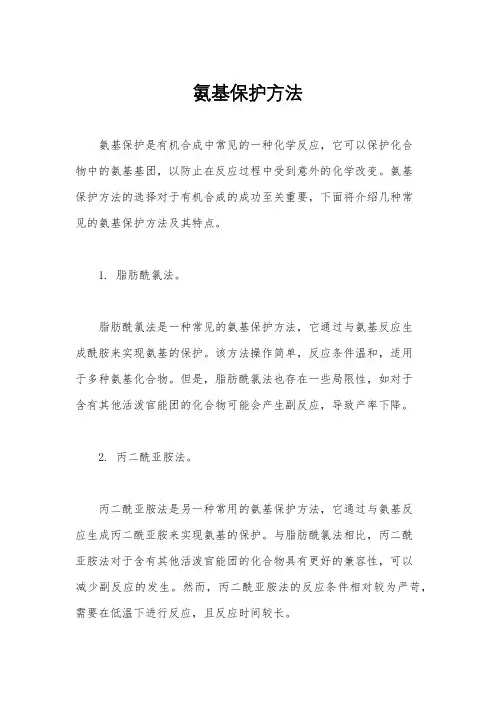
氨基保护方法氨基保护是有机合成中常见的一种化学反应,它可以保护化合物中的氨基基团,以防止在反应过程中受到意外的化学改变。
氨基保护方法的选择对于有机合成的成功至关重要,下面将介绍几种常见的氨基保护方法及其特点。
1. 脂肪酰氯法。
脂肪酰氯法是一种常见的氨基保护方法,它通过与氨基反应生成酰胺来实现氨基的保护。
该方法操作简单,反应条件温和,适用于多种氨基化合物。
但是,脂肪酰氯法也存在一些局限性,如对于含有其他活泼官能团的化合物可能会产生副反应,导致产率下降。
2. 丙二酰亚胺法。
丙二酰亚胺法是另一种常用的氨基保护方法,它通过与氨基反应生成丙二酰亚胺来实现氨基的保护。
与脂肪酰氯法相比,丙二酰亚胺法对于含有其他活泼官能团的化合物具有更好的兼容性,可以减少副反应的发生。
然而,丙二酰亚胺法的反应条件相对较为严苛,需要在低温下进行反应,且反应时间较长。
3. 三氯甲烷法。
三氯甲烷法是一种较为特殊的氨基保护方法,它通过与氨基反应生成三氯甲基化合物来实现氨基的保护。
该方法适用于对其他保护基敏感的化合物,可以避免副反应的发生。
然而,三氯甲烷法的操作相对较为复杂,需要在惰性气氛下进行反应,且对于一些氨基化合物可能存在选择性不足的问题。
4. 肟醚法。
肟醚法是一种较为温和的氨基保护方法,它通过与氨基反应生成肟醚化合物来实现氨基的保护。
该方法操作简便,反应条件温和,适用于多种氨基化合物。
然而,肟醚法在一些情况下可能会产生副反应,导致产率下降。
综上所述,氨基保护方法的选择应根据具体的化合物结构和反应条件来进行合理的考虑。
在实际应用中,我们可以根据需要综合考虑不同氨基保护方法的特点,选择最适合的方法进行保护,以确保有机合成的顺利进行。
希望本文介绍的氨基保护方法能为有机化学领域的研究工作提供一定的参考价值。
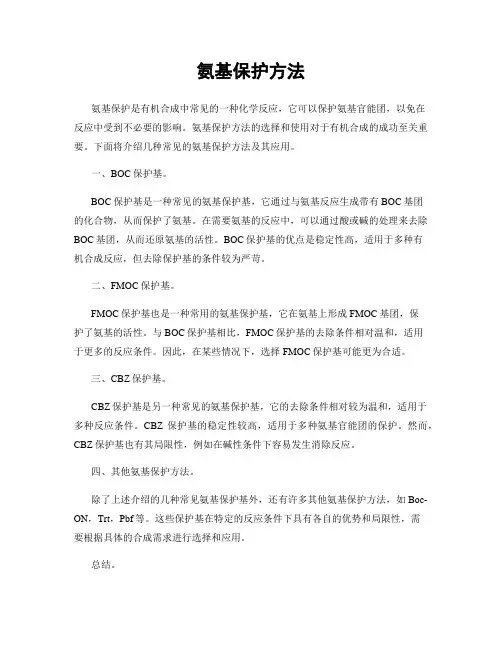
氨基保护方法氨基保护是有机合成中常见的一种化学反应,它可以保护氨基官能团,以免在反应中受到不必要的影响。
氨基保护方法的选择和使用对于有机合成的成功至关重要。
下面将介绍几种常见的氨基保护方法及其应用。
一、BOC保护基。
BOC保护基是一种常见的氨基保护基,它通过与氨基反应生成带有BOC基团的化合物,从而保护了氨基。
在需要氨基的反应中,可以通过酸或碱的处理来去除BOC基团,从而还原氨基的活性。
BOC保护基的优点是稳定性高,适用于多种有机合成反应,但去除保护基的条件较为严苛。
二、FMOC保护基。
FMOC保护基也是一种常用的氨基保护基,它在氨基上形成FMOC基团,保护了氨基的活性。
与BOC保护基相比,FMOC保护基的去除条件相对温和,适用于更多的反应条件。
因此,在某些情况下,选择FMOC保护基可能更为合适。
三、CBZ保护基。
CBZ保护基是另一种常见的氨基保护基,它的去除条件相对较为温和,适用于多种反应条件。
CBZ保护基的稳定性较高,适用于多种氨基官能团的保护。
然而,CBZ保护基也有其局限性,例如在碱性条件下容易发生消除反应。
四、其他氨基保护方法。
除了上述介绍的几种常见氨基保护基外,还有许多其他氨基保护方法,如Boc-ON,Trt,Pbf等。
这些保护基在特定的反应条件下具有各自的优势和局限性,需要根据具体的合成需求进行选择和应用。
总结。
氨基保护方法的选择和使用对于有机合成的成功至关重要。
在选择氨基保护基时,需要考虑反应条件、保护基的稳定性、去除条件等因素。
合理选择氨基保护方法,可以保护氨基的活性,促进有机合成反应的进行,提高合成产物的纯度和收率。
结语。
通过本文的介绍,相信大家对氨基保护方法有了更深入的了解。
在有机合成中,选择合适的氨基保护方法对于合成目标化合物的成功至关重要。
希望本文能够对大家的研究和实践工作有所帮助。
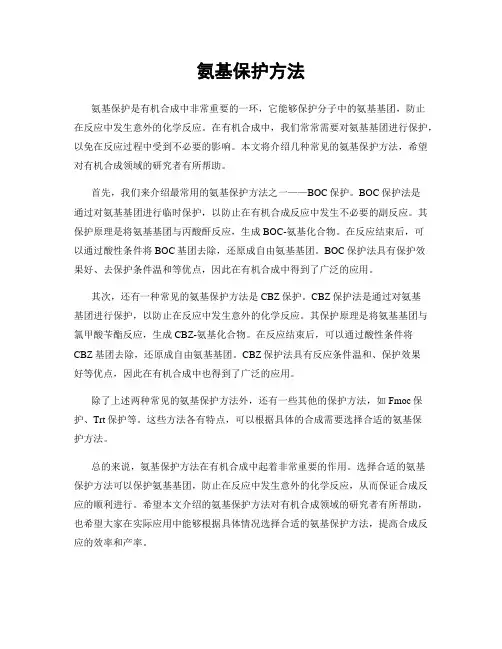

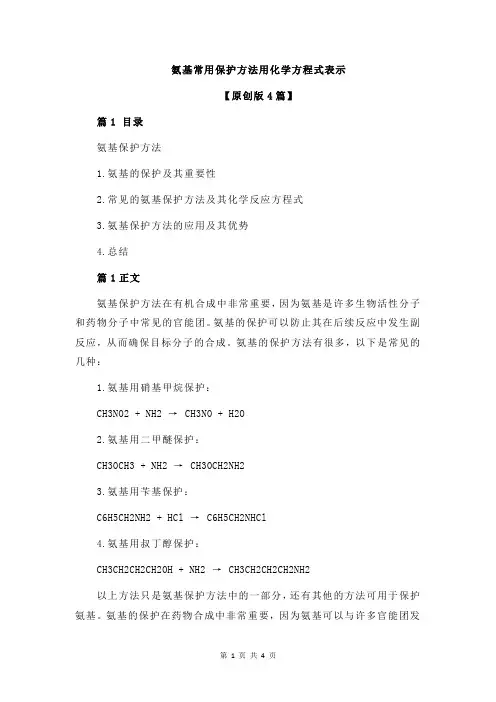
氨基常用保护方法用化学方程式表示【原创版4篇】篇1 目录氨基保护方法1.氨基的保护及其重要性2.常见的氨基保护方法及其化学反应方程式3.氨基保护方法的应用及其优势4.总结篇1正文氨基保护方法在有机合成中非常重要,因为氨基是许多生物活性分子和药物分子中常见的官能团。
氨基的保护可以防止其在后续反应中发生副反应,从而确保目标分子的合成。
氨基的保护方法有很多,以下是常见的几种:1.氨基用硝基甲烷保护:CH3NO2 + NH2 → CH3NO + H2O2.氨基用二甲醚保护:CH3OCH3 + NH2 → CH3OCH2NH23.氨基用苄基保护:C6H5CH2NH2 + HCl → C6H5CH2NHCl4.氨基用叔丁醇保护:CH3CH2CH2CH2OH + NH2 → CH3CH2CH2CH2NH2以上方法只是氨基保护方法中的一部分,还有其他的方法可用于保护氨基。
氨基的保护在药物合成中非常重要,因为氨基可以与许多官能团发生反应,如羧酸、酯、酰胺等。
篇2 目录氨基保护方法1.氨基的保护2.氨基的脱保护3.氨基的保护与脱保护的应用篇2正文氨基的保护氨基的保护方法有多种,其中最常见的是用CN基团保护氨基。
在CN基团的保护下,氨基可以与C=N键共价结合,形成-CONH-键。
CN基团可以用CN基团保护氨基的化学方程式表示:R-NH2 + CN → RCONH2。
氨基的脱保护氨基的脱保护方法也有多种,其中最常见的是用酸水解法脱保护。
在酸的作用下,C=N键被打开,氨基重新暴露出来。
氨基的保护与脱保护的应用氨基的保护与脱保护可以应用于许多领域,例如有机合成、药物合成、材料合成等。
在有机合成中,氨基的保护可以防止氨基与其它基团发生反应,从而保护产物的纯度。
在药物合成中,氨基的保护可以防止氨基与其它基团发生反应,从而保护药物的功效。
在材料合成中,氨基的保护可以防止氨基与其它基团发生反应,从而保护材料的性能。
篇3 目录氨基常用保护方法1.氨基的保护2.氨基的保护方法3.氨基的保护原理4.氨基的保护应用5.氨基的保护注意事项篇3正文氨基常用保护方法1.氨基的保护氨基是氨基酸的重要官能团,在合成有机化合物时,氨基需要进行保护,以防止其与其它官能团或基团发生反应。
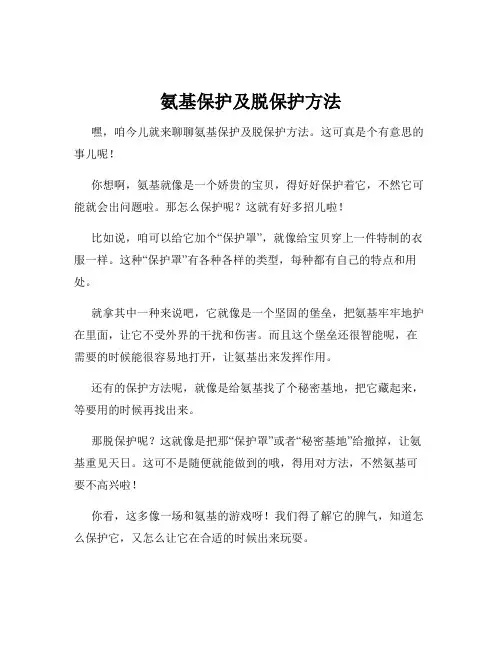
氨基保护及脱保护方法嘿,咱今儿就来聊聊氨基保护及脱保护方法。
这可真是个有意思的事儿呢!你想啊,氨基就像是一个娇贵的宝贝,得好好保护着它,不然它可能就会出问题啦。
那怎么保护呢?这就有好多招儿啦!比如说,咱可以给它加个“保护罩”,就像给宝贝穿上一件特制的衣服一样。
这种“保护罩”有各种各样的类型,每种都有自己的特点和用处。
就拿其中一种来说吧,它就像是一个坚固的堡垒,把氨基牢牢地护在里面,让它不受外界的干扰和伤害。
而且这个堡垒还很智能呢,在需要的时候能很容易地打开,让氨基出来发挥作用。
还有的保护方法呢,就像是给氨基找了个秘密基地,把它藏起来,等要用的时候再找出来。
那脱保护呢?这就像是把那“保护罩”或者“秘密基地”给撤掉,让氨基重见天日。
这可不是随便就能做到的哦,得用对方法,不然氨基可要不高兴啦!你看,这多像一场和氨基的游戏呀!我们得了解它的脾气,知道怎么保护它,又怎么让它在合适的时候出来玩耍。
有时候我就想,这氨基保护和脱保护就像是一场魔术表演。
我们是魔术师,氨基就是那个神奇的道具,我们得用巧妙的手法让它在保护和脱保护之间变幻自如。
想象一下,我们就像一群聪明的科学家,在实验室里摆弄着各种试剂和仪器,为了找到最合适的氨基保护和脱保护方法而努力着。
每一次的尝试都是一次冒险,每一次的成功都让人兴奋不已。
哎呀,这氨基保护及脱保护方法可真是太重要啦!它关系到好多化学反应的进行,关系到好多产品的生产呢!要是没有这些方法,那得乱套了呀!所以说呀,咱可得好好研究研究这些方法,让它们为我们所用,创造出更多更好的东西来。
这可不是开玩笑的事儿,这是关乎科学进步和人类发展的大事儿呢!总之呢,氨基保护及脱保护方法是化学领域里非常重要的一部分,就像一把钥匙,能打开许多未知的大门。
我们要不断探索,不断尝试,让这把钥匙发挥出更大的作用!你说是不是呢?。

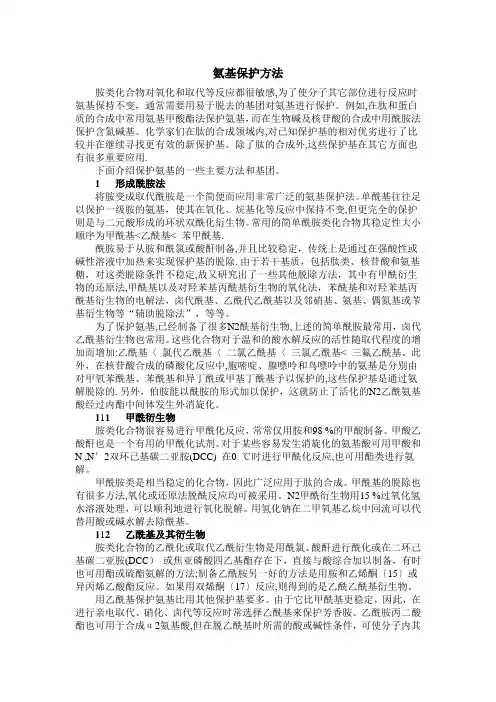
氨基保护方法胺类化合物对氧化和取代等反应都很敏感,为了使分子其它部位进行反应时氨基保持不变,通常需要用易于脱去的基团对氨基进行保护。
例如,在肽和蛋白质的合成中常用氨基甲酸酯法保护氨基,而在生物碱及核苷酸的合成中用酰胺法保护含氮碱基。
化学家们在肽的合成领域内,对已知保护基的相对优劣进行了比较并在继续寻找更有效的新保护基。
除了肽的合成外,这些保护基在其它方面也有很多重要应用.下面介绍保护氨基的一些主要方法和基团。
1 形成酰胺法将胺变成取代酰胺是一个简便而应用非常广泛的氨基保护法。
单酰基往往足以保护一级胺的氨基,使其在氧化、烷基化等反应中保持不变,但更完全的保护则是与二元酸形成的环状双酰化衍生物。
常用的简单酰胺类化合物其稳定性大小顺序为甲酰基<乙酰基< 苯甲酰基.酰胺易于从胺和酰氯或酸酐制备,并且比较稳定,传统上是通过在强酸性或碱性溶液中加热来实现保护基的脱除.由于若干基质,包括肽类、核苷酸和氨基糖,对这类脱除条件不稳定,故又研究出了一些其他脱除方法,其中有甲酰衍生物的还原法,甲酰基以及对羟苯基丙酰基衍生物的氧化法,苯酰基和对羟苯基丙酰基衍生物的电解法,卤代酰基、乙酰代乙酰基以及邻硝基、氨基、偶氮基或苄基衍生物等“辅助脱除法”,等等。
为了保护氨基,已经制备了很多N2酰基衍生物,上述的简单酰胺最常用,卤代乙酰基衍生物也常用。
这些化合物对于温和的酸水解反应的活性随取代程度的增加而增加:乙酰基〈氯代乙酰基〈二氯乙酰基〈三氯乙酰基< 三氟乙酰基。
此外,在核苷酸合成的磷酸化反应中,胞嘧啶、腺嘌呤和鸟嘌呤中的氨基是分别由对甲氧苯酰基、苯酰基和异丁酰或甲基丁酰基予以保护的,这些保护基是通过氨解脱除的.另外,伯胺能以酰胺的形式加以保护,这就防止了活化的N2乙酰氨基酸经过内酯中间体发生外消旋化。
111 甲酰衍生物胺类化合物很容易进行甲酰化反应,常常仅用胺和98 %的甲酸制备。
甲酸乙酸酐也是一个有用的甲酰化试剂。
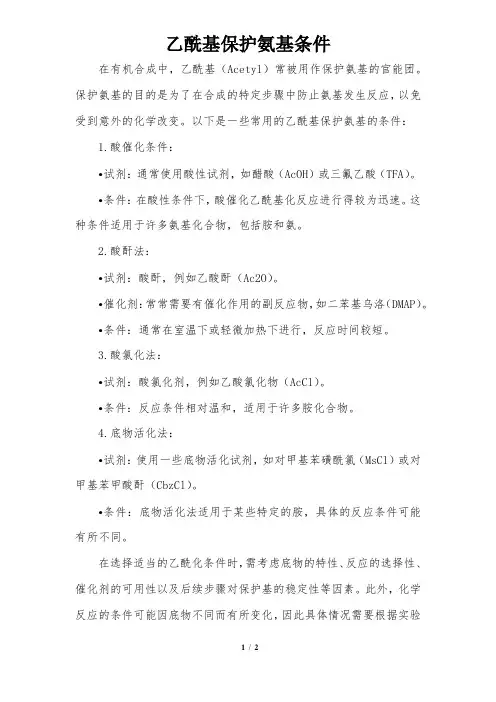
乙酰基保护氨基条件
在有机合成中,乙酰基(Acetyl)常被用作保护氨基的官能团。
保护氨基的目的是为了在合成的特定步骤中防止氨基发生反应,以免受到意外的化学改变。
以下是一些常用的乙酰基保护氨基的条件:
1.酸催化条件:
•试剂:通常使用酸性试剂,如醋酸((AcOH)或三氟乙酸((TFA)。
•条件:在酸性条件下,酸催化乙酰基化反应进行得较为迅速。
这种条件适用于许多氨基化合物,包括胺和氨。
2.酸酐法:
•试剂:酸酐,例如乙酸酐(Ac2O)。
•催化剂:常常需要有催化作用的副反应物,如二苯基乌洛((DMAP)。
•条件:通常在室温下或轻微加热下进行,反应时间较短。
3.酸氯化法:
•试剂:酸氯化剂,例如乙酸氯化物(AcCl)。
•条件:反应条件相对温和,适用于许多胺化合物。
4.底物活化法:
•试剂:使用一些底物活化试剂,如对甲基苯磺酰氯((MsCl)或对甲基苯甲酸酐(CbzCl)。
•条件:底物活化法适用于某些特定的胺,具体的反应条件可能有所不同。
在选择适当的乙酰化条件时,需考虑底物的特性、反应的选择性、催化剂的可用性以及后续步骤对保护基的稳定性等因素。
此外,化学反应的条件可能因底物不同而有所变化,因此具体情况需要根据实验
的需要进行优化。
关于氨基常用保护方法用化学方程式表示的文章氨基是有机化学中常见的官能团之一,它在合成有机化合物和药物中起着重要的作用。
然而,由于氨基的活性较高,容易与其他反应物发生不必要的反应,因此需要采取保护措施来保护氨基团。
下面将介绍几种常用的氨基保护方法,并用化学方程式表示。
1. 丙酮氨基保护法:丙酮是一种常见的有机溶剂,可以与氨基反应生成丙酮氨基。
在合成过程中,可以使用丙酮将氨基保护起来,待需要时再去除保护基。
该方法适用于对空气和水敏感的氨基。
化学方程式:\nR-NH2 + (CH3)2CO → R-NH-C(CH3)32. 二甲亚砜(DMS)氨基保护法:二甲亚砜是一种常用的有机溶剂和还原剂,在合成中可以与氨基反应生成二甲亚砜氨基。
该方法适用于对空气和水敏感的氨基。
化学方程式:\nR-NH2 + (CH3)2SO → R-NH-S(CH3)23. 苄胺氨基保护法:苄胺是一种常用的氨基保护试剂,可以与氨基反应生成苄胺氨基。
该方法适用于对酸和碱敏感的氨基。
化学方程式:\nR-NH2 + C6H5CH2Cl → R-NH-C6H5CH24. 三甲硅烷氨基保护法:三甲硅烷是一种常用的有机硅试剂,可以与氨基反应生成三甲硅烷氨基。
该方法适用于对酸和碱敏感的氨基。
化学方程式:\nR-NH2 + (CH3)3SiCl → R-NH-Si(CH3)3以上是几种常用的氨基保护方法及其化学方程式。
通过选择合适的保护试剂和条件,可以有效地保护氨基团,避免不必要的反应发生。
在需要使用氨基时,再通过适当的去保护方法去除保护基,使得氨基团重新活化。
这些保护方法在有机合成和药物研究中起着重要的作用,为合成复杂有机分子提供了便利。
cbz保护氨基条件氨基是有机化学中非常重要的官能团呢,在很多反应里我们都需要对它进行保护,今天就来说说在CBZ保护氨基的条件。
一、CBZ的简介。
CBZ其实就是苄氧羰基,它是一种很常用的氨基保护基。
这个CBZ基团就像一个小帽子一样,能戴在氨基这个小脑袋上,保护它在一些化学反应中不被破坏。
它的结构里有苄基和羰基,这俩部分组合起来就有了特殊的性质来保护氨基哦。
二、反应溶剂。
在CBZ保护氨基的反应中,溶剂的选择很重要呢。
一般来说,像二氯甲烷这种有机溶剂就很常用。
二氯甲烷是个很好的溶剂,它能够很好地溶解反应物,就像一个舒适的小窝,让反应分子们愉快地在里面进行反应。
而且它的极性比较适中,不会太干扰反应的进行。
除了二氯甲烷,有时候也会用到甲苯之类的溶剂。
甲苯就像是二氯甲烷的大表哥,有着类似的功能,不过它的性质又有点不一样,在一些特定的反应体系里会更适用。
三、碱的使用。
碱在这个反应里可是个重要的角色。
常用的碱有碳酸钠或者碳酸氢钠。
想象一下,碱就像是一个小助手,它能帮助反应顺利进行。
碳酸钠就像是一个强壮的小助手,它的碱性相对强一点。
而碳酸氢钠呢,就像是一个温柔一点的小助手。
它们的存在是为了让反应体系保持合适的酸碱度,这样CBZ试剂才能更好地和氨基发生反应。
如果碱的量不合适,要么反应不完全,就像做饭没煮熟一样,要么就可能会有一些副反应,就像炒菜炒糊了,出现一些我们不想要的东西。
四、反应温度。
反应温度也是个关键因素。
这个反应通常在室温下就可以进行啦。
室温就像是一个很舒服的环境温度,就像我们人在舒适的温度下干活效率高一样,反应分子在室温下也能比较高效地进行反应。
不过呢,有时候也会稍微加热一下,但是温度也不会太高,一般不超过40℃。
如果温度太高了,反应分子就会像热锅上的蚂蚁一样,乱了阵脚,可能会产生很多乱七八糟的反应,就不是我们想要的CBZ保护氨基的反应了。
五、CBZ试剂的用量。
CBZ试剂的用量也得好好把握。
一般来说,会稍微过量一点。
一、实验目的1. 学习和掌握氨基保护的原理和方法。
2. 了解不同氨基保护基团的性质和应用。
3. 掌握实验操作技能,提高实验操作的准确性。
二、实验原理氨基保护是指在有机合成中,为了防止氨基与其他官能团发生不必要的反应,而采用特定的保护基团对氨基进行保护。
常见的氨基保护基团有Fmoc、Boc、Tboc等。
这些保护基团与氨基反应生成稳定的氨基保护酯,在后续反应中可以保持氨基的稳定性。
三、实验材料与仪器1. 实验材料:- 苯胺- Fmoc-Cl- DMF(N,N-二甲基甲酰胺)- DCM(二氯甲烷)- 冰乙酸- 无水硫酸钠- 乙醇- 乙酸乙酯- 碱性氧化铝- 乙醇/水溶液2. 实验仪器:- 烧杯- 分液漏斗- 烧瓶- 蒸发皿- 冷却水浴- 真空泵- 恒温水浴- 红外光谱仪- 核磁共振波谱仪四、实验步骤1. Fmoc保护(1)在烧杯中加入苯胺和Fmoc-Cl,加入适量的DMF溶解。
(2)将混合液置于冷却水浴中,缓慢搅拌。
(3)加入适量的冰乙酸,调节pH值至6.5-7.0。
(4)继续搅拌反应30分钟。
(5)用饱和NaHCO3溶液洗涤反应液,去除未反应的Fmoc-Cl。
(6)用无水硫酸钠干燥反应液。
(7)过滤,收集滤液,用乙醇/水溶液洗涤滤渣。
(8)将滤液蒸发至干燥,得到Fmoc保护的苯胺。
2. Boc保护(1)在烧杯中加入Fmoc保护的苯胺和Boc-Cl,加入适量的DMF溶解。
(2)将混合液置于冷却水浴中,缓慢搅拌。
(3)加入适量的冰乙酸,调节pH值至6.5-7.0。
(4)继续搅拌反应30分钟。
(5)用饱和NaHCO3溶液洗涤反应液,去除未反应的Boc-Cl。
(6)用无水硫酸钠干燥反应液。
(7)过滤,收集滤液,用乙醇/水溶液洗涤滤渣。
(8)将滤液蒸发至干燥,得到Boc保护的苯胺。
3. Tboc保护(1)在烧杯中加入Boc保护的苯胺和Tboc-Cl,加入适量的DMF溶解。
(2)将混合液置于冷却水浴中,缓慢搅拌。
合成中保护氨基的试剂一、引言保护基是有机合成中常用的一种策略,它可以在某些反应条件下保护特定的官能团,从而避免其发生副反应或互相干扰。
在合成中保护氨基的试剂的选择和使用对于有机化学研究和应用具有重要意义。
本文将重点介绍几种常见的保护氨基试剂及其应用。
二、有机合成中常见的保护氨基试剂及应用1. BOC-氨基保护试剂BOC(tert-butyloxycarbonyl)-氨基保护试剂是一种常用的氨基保护试剂。
它能够通过与氨基反应生成稳定的BOC-氨基酸酯,从而保护氨基。
在需要进行其他反应的时候,可以通过酸催化下的脱保护反应将BOC保护基去除,恢复原始的氨基官能团。
BOC-氨基保护试剂在肽合成和天然产物合成中得到了广泛的应用。
2. Fmoc-氨基保护试剂Fmoc(9-氟酰基甲氧羰基)-氨基保护试剂是另一种常见的氨基保护试剂。
它能够与氨基反应生成稳定的Fmoc-氨基酸酯,从而保护氨基。
与BOC类似,Fmoc-氨基保护试剂也可以通过碱催化下的脱保护反应将Fmoc保护基去除。
Fmoc-氨基保护试剂在固相合成中广泛应用,特别是在肽合成中。
3. Trityl-氨基保护试剂Trityl(三苯甲基)-氨基保护试剂是一种常用的氨基保护试剂。
它可以与氨基反应生成稳定的Trityl-氨基酸酯,从而保护氨基。
和前两种试剂类似,Trityl-氨基保护试剂也可以通过酸催化下的脱保护反应将Trityl保护基去除。
Trityl-氨基保护试剂在肽合成和核苷酸合成中得到了广泛的应用。
4. Cbz-氨基保护试剂Cbz(苄氧羰基)-氨基保护试剂是一种常见的氨基保护试剂。
它可以与氨基反应生成稳定的Cbz-氨基酸酯,从而保护氨基。
和前面提到的试剂类似,Cbz-氨基保护试剂也可以通过酸催化下的脱保护反应将Cbz保护基去除。
Cbz-氨基保护试剂在肽合成和药物合成中得到了广泛的应用。
三、总结合成中保护氨基的试剂是有机化学研究和应用中不可或缺的工具。
本文介绍了几种常见的保护氨基试剂及其应用,包括BOC-氨基保护试剂、Fmoc-氨基保护试剂、Trityl-氨基保护试剂和Cbz-氨基保护试剂。
氨基保护方法范文氨基保护方法是一种化学合成中常用的手段,用于保护氨基(-NH2)官能团,以避免其在合成过程中发生不必要的反应或者失去活性。
氨基保护方法可以保持氨基的稳定性,并在合适的条件下去除保护基,以还原氨基的活性。
下面介绍几种常见的氨基保护方法。
一、酰氨和酰基保护:在化学合成中,常见的氨基保护方法是通过在氨基上引入酰保护基。
酰保护基是羰基化合物(如酰氯或酸酐)与胺反应生成的酰胺。
常用的酰保护基有甲酰(CHO)、乙酰(C2H5CO)、苯甲酰(C6H5CO)等。
在酰保护基的保护下,氨基能够稳定存在,并且不容易发生反应。
当需要还原氨基活性时,可以通过酸或碱的处理来去除酰保护基。
二、酰氧和醛缩糖保护:在糖化学合成中,常见的氨基保护方法是使用酰氧和醛缩糖化合物作为保护基。
酰氧保护基是通过与糖的氢氧基发生酯化反应形成的酯化产物。
醛缩糖保护是通过与糖的醛基发生缩合反应形成缩糖保护基。
这些保护基可以有效地保护糖分子中的氨基官能团,并在需要时通过合适的反应条件去除。
三、硅烷保护:氨基官能团也可以通过硅烷保护基来保护。
硅烷保护是将氨基与硅烷化合物(如三甲基硅烷)反应生成硅烷化合物。
硅烷保护基可以有效地保护氨基官能团,并且可以在需要时通过酸或碱的处理去除。
四、酮醇保护:在一些特殊情况下,氨基也可以通过酮醇保护基来保护。
酮醇保护是将氨基与酮醇化合物(如吡咯基甲醇)反应生成酮醇化合物。
酮醇保护基的保护效果比较强,可以在极端的反应条件下保护氨基官能团。
在实际应用中,选择合适的氨基保护方法需要考虑多个因素,包括:反应条件、保护效果、保护基的易去除性等。
同时,还需要根据具体合成需求综合考虑保护基的稳定性、毒性等因素,以及对后续步骤的影响。
总之,氨基保护方法是化学合成中常用的手段之一,能够有效地保护氨基官能团,并在需要时恢复其活性。
不同的保护方法可以根据具体需求选择,以提高合成反应的效率和产率。
渡岸学术搜索网 繁體中文|加入收藏 首页 | 图文 | 医学 | 药学 | 生物 | 化学 | 理工 | 材料 | 经济 | 国内英语 | 检索 | IT&others |当前位置: 首页 >> 化学 >> 有机&合成 >> 氨基的各种保护氨基的各种保护本文归类于: 氨基 来源:[网络搜索] 发表:2007-06-01 浏览:188188 字号:大 中 小 下载分卷附件前必看===氨基相关链接===● 氨基酸的背诵口诀 [2007/0725]●L-8900 DATA\L8800氨基酸分析仪中文资料\L8800氨基... [2007/0404]●氨基酸分析仪常见问题 [2007/0403]●超临界流体提取氨基酸的一篇外文文献+SFE -MS 分析... [2007/0105]●洛美沙星注射液与3种氨基糖苷类药物配伍的稳定性 [2006/1226]氨基的各种保护t Bu - (tert -butyl) esterStandard Protection ProcedureTo a solution of the N-protected aminoacid, DMAP (0.5 eq), and tBuOH (1.2 eq) in dry DCM at 0° under an inert atmosphere, is added EDCI (1.1. eq) and stirred for 2 h. The mixture is then stirred at room temperature until complete by TLC (usually 14 h) and concentrated invacuo . The residue is redissolved in ethyl acetate and extracted twice with water, then twice with aqueous saturated sodium bicarbonate.The organic solution is dried (magnesium sulfate) and concentrated in vacuo . The residue is purified by flash chromatography (SiO 2) if necessary.RemovalThe compound is dissolved in formic acid and stirred at room temperature until the reaction is complete by TLC (usually 12 hours). The solution is then concentrated and coconcentrated several times with toluene. The resulting residue can then be purified by flash chromatography (SiO 2) if necessary.ReferencesJ. Chem. Soc., Perkin Trans. 1, 1996, 985-993. JOC, 1982, 47, 1962-1965.[Back to Top ] [Back to Synthetic Procedures]Bn - (benzyl) esterStandard Protection ProcedureThe amino acid is stirred with dry THF and O-benzyl-N,N'-diisopropylisourea (see ref. for synthesis) at room temperature under an inert atmosphere until complete by TLC (usually 2 days). The mixture is cooled to -20 C and filtered. The filtrate is concentrated in vacuo and purified by flash chromatography (SiO2) if necessary.RemovalThe amino acid derivative is dissolved in 1:1 methanol:t-butanol and Pd(OH)2-C is added under a hydrogen atmosphere. The mixture is allowed to stir until complete by TLC (usually >3 h), then filtered and concentrated. The resulting residue can then be purified by flash chromatography (SiO2) if necessary.ReferencesMacromolecules, 1978, 534-539.[Back to Top] [Back to Synthetic Procedures]Allyl - (allyl) esterStandard Protection ProcedureThe compound is dissolved in dry DCM and allyl alcohol (1.1 eq) is added. The solution is stirred under an inert atmosphere at 0° and dicyclohexylcarbodiimide (1 eq) is added followed by 4-N,N-dimethylaminopyridine (0.05 eq). The reaction is allowed to warm to room temperature and is stirred until complete by TLC (usually 1-2 days). Ethyl acetate is added and theresulting precipitate is removed by filtration. The filtrate is concentrated in vacuo and purified by flash chromatography (SiO2) if necessary.RemovalThe amino acid and pyrrolidine (1.2 eq) are dissolved in methylene chloride and cooled to -15°. Triphenylphosphine (0.2 eq) and Tetrakis(triphenylphosphine)palladium (0) (0.05 eq) are added and stirred under an inert atmosphere for approx. 1 h.Water and acetonitrile are added and the resulting mixture is extracted twice with petroleum ether. The acetonitrile layer is evaporated and purified by flash chromatography (SiO2) if necessary.ReferencesTetrahedron, 1996, 52, 12839-12852.[Back to Top] [Back to Synthetic Procedures]PfP - (pentafluorophenyl) esterStandard Protection ProcedureThe acid is dissolved in ethyl acetate and pentafluorophenol (1.2 eq) is added. The solution is cooled to 0° and DCC (1.2 eq) is added. The reaction is allowed to warm to room temperature and stir until complete by TLC (usually overnight, if notcomplete more DCC may be added). The solution is then filtered through celite, rinsed several times with EtOAc, andconcentrated in vacuo. The resulting residue can then be purified by flash chromatography (SiO2) if necessary.ReferencesJ. Chem. Soc., Perkin Trans. 1, 1996, 985-993.[Back to Top] [Back to Synthetic Procedures]Me - (methyl) esterStandard Protection ProcedureThe compound is dissolved in dry MeOH and thionyl chloride (2 eq) is added drop wise at 0° under an inert atmosphere. The result is then refluxed until complete by TLC (usually >4 hours) and concentrated in vacuo. The residue can then be purified by flash chromatography (SiO2) if necessary.RemovalThe ester is dissolved in methanol and 1N NaOH is added (excess). The solution is then heated to reflux and stirred until complete by TLC (usually <1 h). Glacial acetic acid is added until the mixture is neutral and then diluted with chloroform.The organic solution is extracted once with water, once with brine, dried (magnesium sulfate), and concentrated in vacuo.The residue is purified by flash chromatography (SiO2) if necessary.ReferencesEur. J. Org. Chem. 1999, 1127-1135.JOC, 1995, 60, 2318-2319.[Back to Top] [Back to Synthetic Procedures]PMB - (para-methoxybenzyl) esterStandard Protection ProcedureThe acid is dissolved in dry DCM and 4-methoxybenzyl alcohol (1.1 eq) is added. The solution is stirred under an inert atmosphere at 0° and dicyclohexylcarbodiimide (1 eq) is added followed by 4-N,N-dimethylaminopyridine (0.05 eq). The reaction is allowed to warm to room temperature and is stirred until complete by TLC (usually 1-2 days). Ethyl acetate is added and the resulting precipitate is removed by filtration. The filtrate is concentrated in vacuo and purified by flash chromatography (SiO2) if necessary.RemovalThe ester is dissolved in phenol and TFA (1-2 eq) is added under an inert atmosphere at 45°. The reaction is stirred until complete by TLC (usually <2 h) and ethyl acetate/water are added. The aqueous layer is extracted 2 times with EtOAc and the organic layer is back extracted twice with saturated sodium bicarbonate solution. The combined aqueous layers are acidified to a pH of 1 with 10% HCl, then extracted 3 times with EtOAc. The combined organic layers are dried (sodium sulfate) and concentrated in vacuo. The residue is then purified by flash chromatography (SiO2) if necessary.ReferencesTetrahedron, 1996, 52, 12839-12852.Tetrahedron Lett. 1990, 31, 6661-6662.[Back to Top] [Back to Synthetic Procedures]MEM - (methoxyethoxymethyl) esterStandard Protection ProcedureTo compound dissolved in a saturated aqueous sodium bicarbonate solution at room temperature, TBAI (1 eq) andmethoxyethyloxymethyl chloride (1.2 eq) are added. The reaction is stirred until complete by TLC (usually 16 h) anddichloromethane is added. The organic layer is washed with water, dried (sodium sulfate), and concentrated in vacuo. The resulting residue can then be purified by flash chromatography (SiO2) if necessary.RemovalThe ester is dissolved in DCM and magnesium bromide etherate (excess) is added at room temperature under an inertatmosphere. The mixture is stirred for 48 h and water is added. The slurry is stirred vigorously for another 2 h and 1N aqueous hydrochloric acid is added until the pH is 1-2. The mixture is extracted with ethyl acetate three times and the combined organic layers are dried (sodium sulfate), then concentrated in vacuo. The resulting residue can then be purified by flash chromatography (SiO2) if necessary.ReferencesJOC, 1994, 59, 2314-2323.Synthesis, 1979, 957-961.[Back to Top] [Back to Synthetic Procedures]Boc - (t Butyloxy) carbamateStandard Protection ProcedureThe amine is dissolved in water and sodium bicarbonate (2 eq) is added with stirring. The resulting solution is cooled to 5° and BOC anhydride (1.5 eq) is added slowly as a solution in para-dioxane (also cooled). The resulting mixture is stirred at 0° for 1 h and allowed to warm to room temperature overnight. Water is then added and the aqueous layer is extracted 2 times with EtOAc. The organic layer is back extracted twice with saturated sodium bicarbonate solution. The combined aqueous layers are acidified to a pH of 1 with 10% HCl, then extracted 3 times with EtOAc. The combined organic layers are dried (sodium sulfate) and concentrated in vacuo. The resulting residue can then be purified by flash chromatography (SiO2) if necessary.RemovalThe compound is dissolved in 1:1 trifluoroacetic acid:water and stirred at room temperature until complete by TLC (usually <2h). The solution is concentrated in vacuo and purified by flash chromatography (SiO2) if necessary.ReferencesOrganic Synthesis, 1999, 76, 57-76.Novabiochem Catalog, 2002-2003, pg 2.64-2.65.[Back to Top] [Back to Synthetic Procedures]Fmoc - (9-fluorenylmethyl) carbamateStandard Protection ProcedureThe amine is dissolved in water and sodium bicarbonate (2 eq) is added with stirring. The resulting solution is cooled to 5° and Fmoc-OSu or Fmoc-Cl (1.5 eq) is added slowly as a solution in para-dioxane (also cooled). The resulting mixture is stirred at 0° for 1 h and allowed to warm to room temperature overnight. Water is then added and the aqueous layer is extracted 2 times with EtOAc. The organic layer is back extracted twice with saturated sodium bicarbonate solution. The combined aqueous layers are acidified to a pH of 1 with 10% HCl, then extracted 3 times with EtOAc. The combined organic layers are dried (sodium sulfate) and concentrated in vacuo. The resulting residue can then be purified by flash chromatography (SiO2) if necessary.RemovalThe compound is dissolved in a solution of 20% piperidine in DMF. The mixture is stirred for 30 minutes at roomtemperature and concentrated in vacuo. The residue can then be purified by flash chromatography (SiO2) if necessary.ReferencesJ. Am. Chem. Soc., 1997, 4, 656-673.Novabiochem Catalog, 2002-2003, pg 2.64-2.65.[Back to Top] [Back to Synthetic Procedures]Alloc - (allyl) carbamateStandard Protection ProcedureThe amine is dissolved in water and sodium carbonate (2.7 eq) is added with stirring. The resulting solution is cooled to 5° and allyl chloroformate (1.5 eq) is added slowly as a solution in para-dioxane (also cooled). The resulting mixture is stirred at 0° for 1 h and allowed to warm to room temperature overnight. Water is then added and the aqueous layer is extracted 2 times with EtOAc. The organic layer is back extracted twice with saturated sodium bicarbonate solution. The combined aqueous layers are acidified to a pH of 1 with 10% HCl, then extracted 3 times with EtOAc. The combined organic layers are dried (sodium sulfate) and concentrated in vacuo. The resulting residue can then be purified by flash chromatography(SiO2) if necessary.RemovalThe amine is dissolved in dry THF and dimethylmalonate (7 eq) followed by tetrakistriphenylphosphine palladium (0.02 eq) are added at room temperature under an inert atmosphere. The reaction is stirred until complete by TLC (usually 24 h) and filtered. The solution is then concentrated in vacuo and the resulting residue is purified by flash chromatography (SiO2) if necessary.ReferencesTetrahedron, 1996, 39, 12839-12852.Tetrahedron Lett. 1986, 23, 2599-2602.[Back to Top] [Back to Synthetic Procedures]Troc - (trichloroethyl) carbamateStandard Protection ProcedureThe amine is dissolved in water and sodium bicarbonate (2 eq) is added with stirring. The resulting solution is cooled to 5° and Troc-OSu or Troc-Cl (1.5 eq) is added slowly as a solution in para-dioxane (also cooled). The resulting mixture is stirred at 0° for 1 hour and allowed to warm to room temperature overnight. Water is then added and the aqueous layer isextracted 2 times with EtOAc. The organic layer is back extracted twice with saturated sodium bicarbonate solution. The combined aqueous layers are acidified to a pH of 3 with 5% HCl, then extracted 3 times with EtOAc. The combined organic layers are dried (sodium sulfate) and concentrated in vacuo. The resulting residue is purified by flash chromatography(SiO2) if necessary.RemovalThe carbamate is dissolved in glacial acetic acid:THF 1:1 and zinc dust (excess) is added. The resulting suspension is stirredat room temperature until complete by TLC (usually <3 h). The mixture is then filtered, concentrated in vacuo andredissolved in chloroform. The solution is washed once with 5% aqueous sodium bicarbonate, dried (sodium sulfate), and concentrated in vacuo. The resulting residue is purified by flash chromatography (SiO2) if necessary.ReferencesCan. J. Chem. 1982, 60, 976.Synthesis, 1983, 671.JOC, 1988, 53, 3108.[Back to Top] [Back to Synthetic Procedures]Cbz - (benzylcarboxy) carbamateStandard Protection ProcedureThe amine is dissolved in water and sodium bicarbonate (2 eq) is added with stirring. The resulting solution is cooled to 5° and Cbz-OSu or Cbz-Cl (1.5 eq) is added slowly as a solution in para-dioxane (also cooled). The resulting mixture is stirred at 0° for 1 h and allowed to warm to room temperature overnight. Water is then added and the aqueous layer is extracted 2 times with EtOAc. The organic layer is back extracted twice with saturated sodium bicarbonate solution. The combined aqueous layers are acidified to a pH of 1 with 10% HCl, then extracted 3 times with EtOAc. The combined organic layers are dried (sodium sulfate) and concentrated in vacuo. The resulting residue is purified by flash chromatography (SiO2) ifnecessary.RemovalThe amino acid derivative is dissolved in 1:1 methanol:t-butanol and Pd(OH)2-C is added under a hydrogen atmosphere. The mixture is allowed to stir until complete by TLC (usually >3 h) then filtered and concentrated in vacuo. The resulting residue is purified by flash chromatography (SiO2) if necessary.ReferencesTetrahedron Lett. 1966, 7, 4765-4768.[Back to Top] [Back to Synthetic Procedures]t Bu - (tert-butyl) etherStandard Protection ProcedureSee: JOC,1975, 6, 675-681 for general procedure.RemovalThe ether is dissolved in 1:1 trifluoroacetic acid:water and stirred at room temperature until the reaction is complete byTLC (usually <2 h). The solution is concentrated and purified by flash chromatography (SiO2) if necessary.ReferencesJOC,1975, 6, 675-681Novabiochem Catalog, 2002-2003, pg 2.64-2.65./mcgarveylab/Carbsyn/AminoAcids.html本站一切内容源于互联网搜索,禁止商用!有任何不妥请联系:xu8513879#(将#换成@),我们在24小时内删除相关内容。